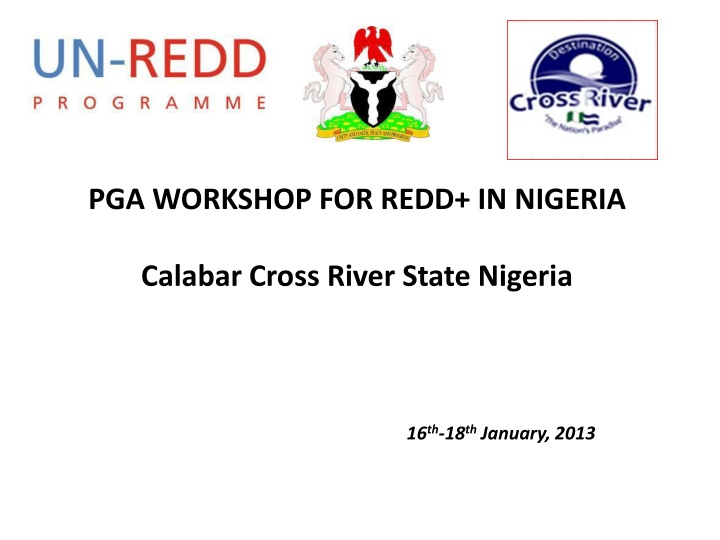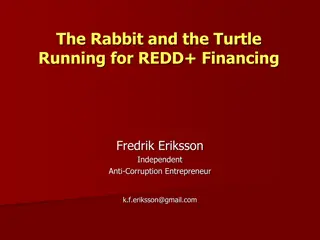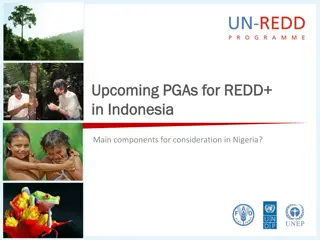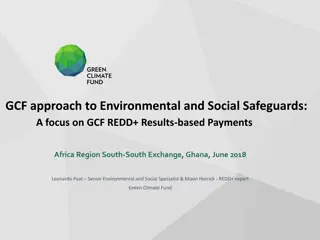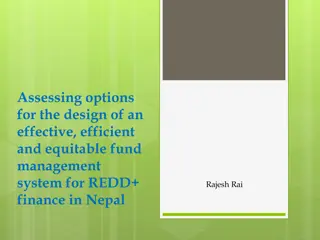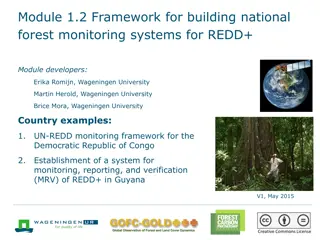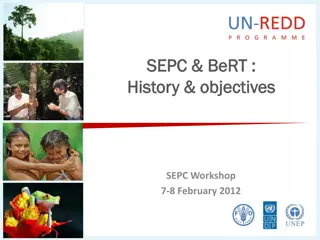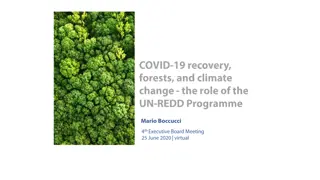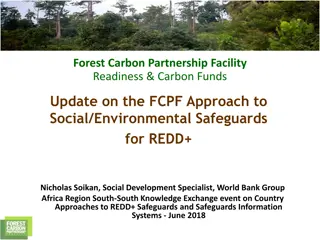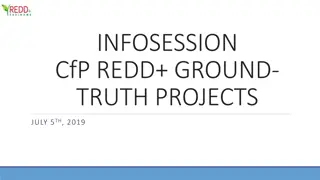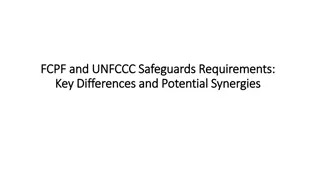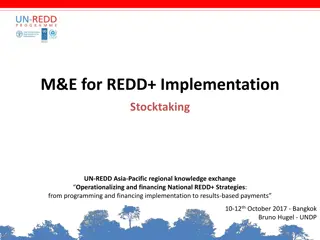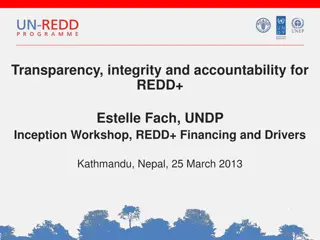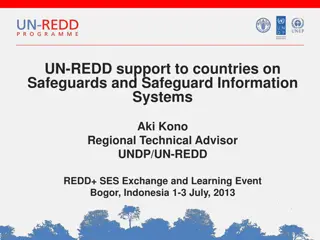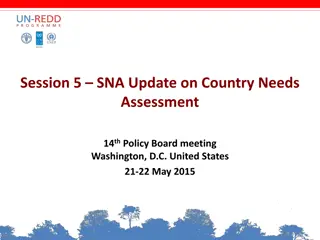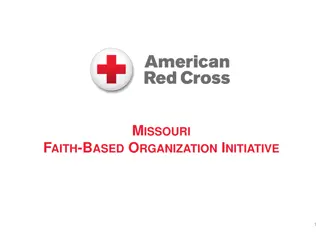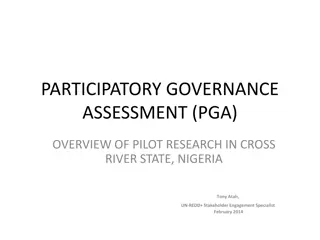PGA WORKSHOP FOR REDD+ IN NIGERIA Calabar Cross River State Nigeria
Criteria for evaluating governance risks and implementing safeguards in community development projects. Topics include fiduciary and fund management systems, feedback mechanisms, and information accessibility among stakeholders.
Download Presentation

Please find below an Image/Link to download the presentation.
The content on the website is provided AS IS for your information and personal use only. It may not be sold, licensed, or shared on other websites without obtaining consent from the author.If you encounter any issues during the download, it is possible that the publisher has removed the file from their server.
You are allowed to download the files provided on this website for personal or commercial use, subject to the condition that they are used lawfully. All files are the property of their respective owners.
The content on the website is provided AS IS for your information and personal use only. It may not be sold, licensed, or shared on other websites without obtaining consent from the author.
E N D
Presentation Transcript
PGA WORKSHOP FOR REDD+ IN NIGERIA Calabar Cross River State Nigeria 16th-18thJanuary, 2013
Presentation of Governance Risks and Possible Safeguards Tony Atah
Criterion 1: Fiduciary & fund management systems Inadequate local capacity for financial management; Undocumented & lack of clarity of guidelines & procedures; Absence of local development plan & budget to guide expenditure. Risks Design a framework for inclusion of stakeholders; Capacity building through training & hands-on support; Develop annual budget linked to implementation of community development plans. Possible Safeguards Extent of involvement of the different community level stakeholders in democratic decision-making about funds management; Number of books/records created and managed to improve accountability. Possible Indicators
Criterion 2: Responsive feedback and grievance mechanisms Lack of grievance procedure Investigation procedure not thorough sometimes Unwillingness to give feedback to, or receive feedback from other stakeholders; Risks Establish benchmark with respect to feedback and grievance mechanism; Support community level institutional capacity building; Develop & communicate a participatory feedback grievance management protocol. Possible Safeguards Number of feedback received Level of quality of two-way feedback received; Number of grievances addressed; Extent to which grievances addressed are satisfactory. Possible Indicators
Criterion 3: Accessibility of information & active dissemination amongst stakeholders Inadequate knowledge & documentation of information; Relevance, appropriateness of language, & timeliness of message delivery; Distortion of information from various sources; Poor institutional & electronic media networks; Risks Train communities on information documentation & dissemination; Use of mixed transmission media & appropriate language; Create information management protocol; Create links between communities & relevant agencies; Improve telecom mast coverage; Possible Safeguards Degree to which information is clearly documented; Extent to which primary stakeholders (i.e. community groups) are aware of, and use information. Possible Indicators
Criterion 4: Active participation of all stakeholders, incl. vulnerable groups Poor stakeholders identification, analysis, & engagement; Withholding information that can encourage participation; Unclear outcomes of participation, unmanaged expectations & suspicion; Groupthink limiting independent critical thinking; Community level exclusive decision making structure; Risks Conduct stakeholders analysis; Engage stakeholders from start; Empower stakeholders through information and roles sharing; Expected benefits should be clearly defined from start Possible Safeguards Number of interest groups at all levels participating; Level of community engagement of vulnerable groups; Extent to which all stakeholders have access to and make use of relevant information Possible Indicators
Criterion 5: Inter-agency coordination Duplicity of institutions and functions; Unclear roles; Unclear levels of authority; Unhealthy competition for authority/recognition Risks Profile existing agencies; Clearly define roles of agencies; Establish inter-agency reporting protocol; Establish a central coordination system Possible Safeguards Number of partnerships between government agencies addressing governance issues related to REDD+; Extent of effectiveness of information disseminated from agencies; Possible Indicators
Criterion 6: Rule of law, access to justice & effective remedies Undocumented procedures & weak institutions; Lack of confidence in the justice system & process; External, more powerful influences; Cost of access to justice and effective remedies. Risks Document processes and strengthen institutions; Make access to justice, effective remedies simple & affordable; Link with relevant external (formal) institutions e.g. the Police; Reform justice & process for greater access, ownership and accountability to local people Possible Safeguards Number of community groups seeking justice; Number of decisions made that are consistent with established procedures; Extent of wide-spread respect for rule of law. Possible Indicators
Criterion 7: Rights of local communities to land & to carbon Forest tenure & management regimes are not very clear; No capacity to measure carbon; Exclusion of less conspicuous yet important resource users; Natural disaster destroying parts of community forests; Government policy; Unclear land boundaries & external competing interventions e.g. Pandrillus. Risks Define tenure systems, capacity needs, resource user groups; Develop/implement capacity building for local institutions; Advocate for evidence based policy formulation; Develop/implement land use condition monitoring; Conduct impact assessments of (external) interventions. Possible Safeguards Number of community bylaws addressing access to forest resources & carbon stock; Extent to which boundaries are clearly defined and maintained between forest management regimes; Number of policies in place that respect the rights of access and ownership by indigenous population Possible Indicators
Criterion 8: Gender equality & womens empowerment Misunderstanding & lack of recognition of gender & women s empowerment needs/issues; Social exclusion in local governance structure & process; Biased livelihoods priorities (preference for male dominant forest based activities to female s) Risks Create awareness based on location-specific issues; Establish systems for inclusion of women in decisions/activities that affect them; Possible Safeguards Number of decisions and actions taken that reflect gender considerations; Extent of involvement of women in decision making processes; Number of measures of gender equity promoted through the REDD+ process Possible Indicators
Criterion 9: Free, prior & informed consent by local communities Unclear benefits & threat to livelihoods support system; Disrespect for local tradition; Exclusion of sections of the community in decision making; Unwillingness of outsiders to sign up MOU with clear implementation plan. Risks Early & broad-based community mobilization & engagement; Clear and honest information dissemination; Respect for communities voices; Establish/enforce standards for trust and partnership building; Adopt participation to develop and communicate future actions Possible Safeguards Number of communities signing FPIC with appropriate implementing agencies; Degree of community ownership of the REDD+ process. Possible Indicators
Criterion 10: .Involuntary resettlements Cultural relevance of new location; Low household income level to support resettlement; Unwillingness of community members to be resettled. Risks Involve communities in considering need for resettlement and available options. Possible Safeguards Number of avoided resettlements; Number of options to resettlement considered before eventual resettlement, if applicable; Average amount/value of compensation for involuntary resettlement; Distance of new settlements to previous location Extent to which communities adapt to their new settlement; Possible Indicators
Criterion 11: Traditional knowledge & cultural heritage Change in belief systems affecting perceptions & behavior; Negative labeling (e.g. evil forest for sacred groves) Inter-generational knowledge gap; Poor documentation of traditional ecological knowledge; Secrecy about indigenous technical knowledge. Risks Use of positive nomenclature in communication strategy e.g. use of sacred or religious grove to evil forest; Documentation and knowledge sharing; Evolve policies and actions for protection of heritage sites Possible Safeguards Size of catalogue of traditional knowledge produced & accessible; Number of cultural heritage sites protected due to increased knowledge about REDD+; Stakeholders level of knowledge about traditional issues; Extent to which traditional knowledge/cultural heritage are integrated in forest management initiatives; Possible Indicators
Criterion 12: Equitable & transparent benefit sharing Weak local institutional framework to support benefit sharing; Limited knowledge of & poor communication about benefits; Absence of benefit sharing formula, except investment in community development projects; Land tenure (ownership) Risk Strengthen institutions for more equitable sharing of benefits and management of conflicts that may ensue; Disseminate information on available benefits; Establish equitable/transparent benefit sharing formula & mechanisms; Establish clear boundary demarcation of forest management regimes (e.g. PAs, Community & Private forests etc) Possible Safeguards Extent to which stakeholders are aware & use benefit sharing formula; Incidence of grievances reported; Stakeholders level of satisfaction with benefit sharing formula and mechanisms; Possible Indicators
Criterion 13: Economic & social well-being of all, including vulnerable groups Poverty can undermine the development process; Natural disaster can affect the well-being of all groups; Poor accessibility can undermine economic & social growth; Undefined benefit management system; Risks Support improvement and/or diversification of livelihoods; Improve access road; Establish disaster risk reduction measures; Develop a robust benefit management system. Possible Safeguards Average household cash income; Number of farmers and resource users adopting improved productivity techniques; Extent of improvement in access to markets; Number of appropriate responses to natural disaster; Level of stakeholders satisfaction with benefits management. Possible Indicators
Summary of key governance issues i. ii. iii. Limited capacity; iv. Land tenure issues; v. Inappropriate policies; vi. Paucity & inefficient dissemination of information; vii. Poor planning; viii. Corruption; ix. Lack of trust and apathy towards participation. Exclusive social and forest governance practices; Limited & low level economic activity engendering poverty;
Question & input time. Thank you for listening.
